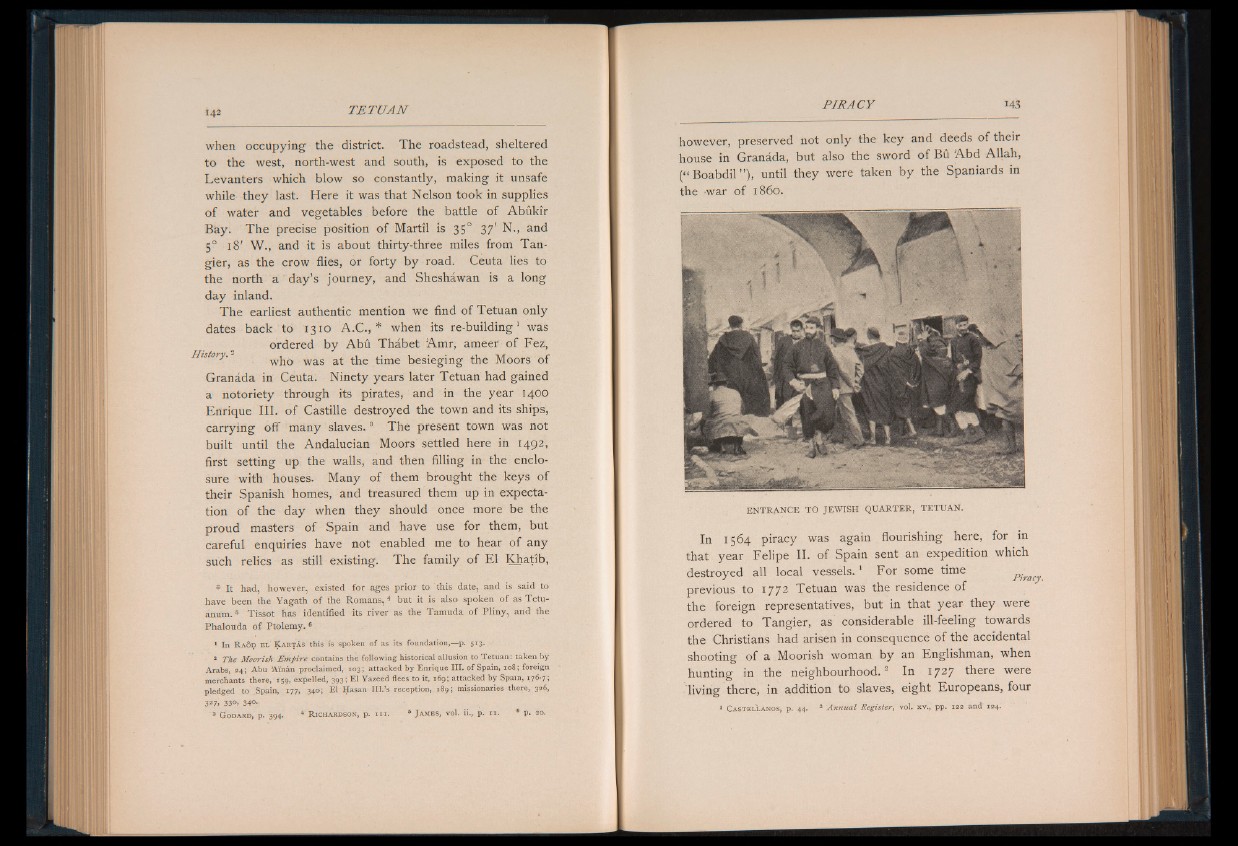
when occupying the district. The roadstead, sheltered
to the west, north-west and south, is exposed to the
Levanters which blow so constantly, making it unsafe
while they last. Here it was that Nelson took in supplies
o f water and vegetables before the battle of Abukir
Bay. The precise position of Martil is 35° 37' N., and
50 18' W., and it is about thirty-three miles from Tangier,
as the crow flies, or forty by road. Ceuta lies to
the north a day’s journey, and Sheshawan is a long
day inland.
The earliest authentic mention we fin dofTetuan only
dates back to 1310 A.C., * when its re-building1 was
ordered by Abu Thabet Amr, ameer of Fez,
who was at the time besieging the Moors of
Granada in Ceuta. Ninety years later Tetuan had gained
a notoriety through its pirates, and in the year 1400
Enrique III. of Castille destroyed the town and its ships,
carrying off many slaves.3 The present town was not
built until the Andalucian Moors settled here in 1492,
first setting up the walls, and then filling in the enclosure
with houses. Many of them brought the keys of
their Spanish homes, and treasured them up in expectation
of the day when they should once more be the
proud masters of Spain and have use for them, but
careful enquiries have not enabled me to hear of any
such relics as still existing. The family of El Khatib,
* It had, however, existed for ages prior to this date, and is said to
have been the Yagath of the Romans, 4 but it is also spoken of as Tetu-
anum. 5 Tissot has identified its river as the Tamuda of Pliny, and the
Phalouda of Ptolemy. 6
1 In R a 6 d e l K a r t a s this is spoken o f as its foundation,— p. 5x3. ■
2 The Moorish Empire contains the following historical allusion to Tetuan: taken by
Arabs, 24; Abu Ainan proclaimed, 103; attacked by Enrique III. of Spain, 108; foreign
merchants there, 159, expelled, 393; El Yazeed flees to it, 169; attacked by Spain, 176-7;
pledged to Spain, 177, 340; El Hasan III.*s reception, 189, missionaries there, 326,
327> 33°> 34°-
3 G o d a r d , p. 394. 4 R i c h a r d s o n , p. i n . 5 J a m e s , vol. ii., p. n . 6 p. 20.
however, preserved not only the key and deeds of their
house in Granada, but also the sword of Bu A b d Allah,
(“ Boabdil” ), until they were taken by the Spaniards in
the war of i860.
ENTRANCE TO JEWISH QU ARTER , TE TU AN .
In 1564 piracy was again flourishing here, for in
that year Felipe II. of Spain sent an expedition which
destroyed all local vessels.1 For some time ^
previous to 1772 Tetuan was the residence of
the foreign representatives, but in that year they were
ordered to Tangier, as considerable ill-feeling towards
the Christians had arisen in consequence of the accidental
shooting of a Moorish woman by an Englishman, when
hunting in the neighbourhood.2 In 1727 there were
living there, in addition to slaves, eight Europeans, four
1 C a s t e l l a n o s , p. 44. 2 Annual Register, vol. xv., pp. 122 and 124.